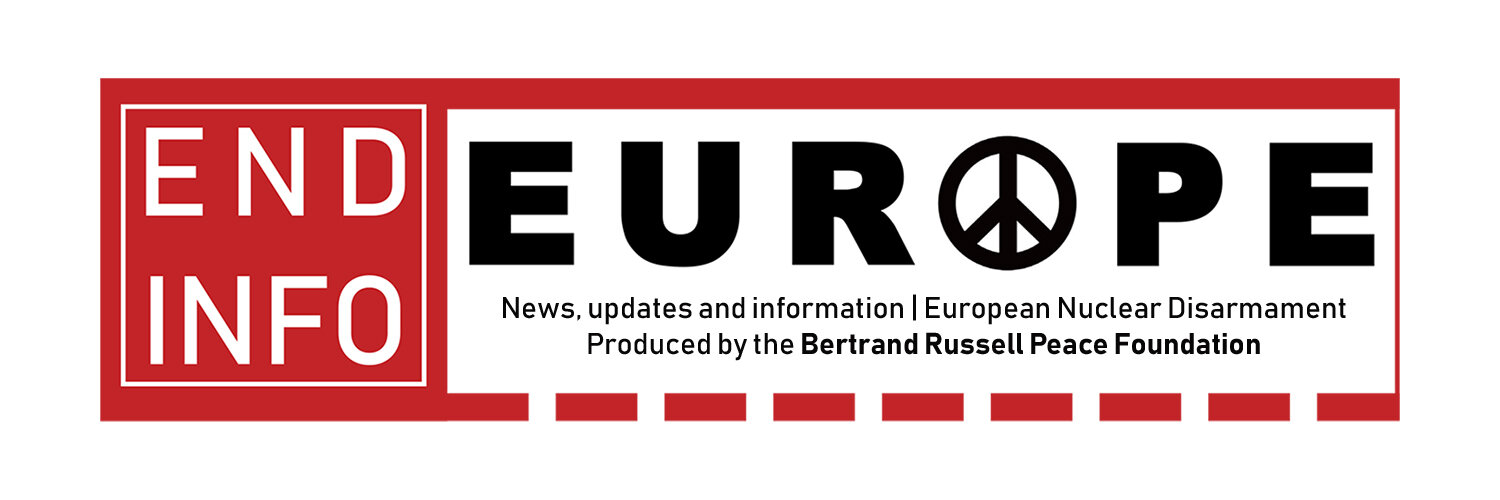Disarmament dominoes
From END Info 28 - Jan/Feb 2022 - DOWNLOAD
By Joachim Wernicke, Berlin
In December 2021, the Russell Foundation received two documents from Joachim Wernicke. The first is titled The End of Nuclear Weapons with Germany as the Catalyst. The second is titled The New NATO Deployments in 2023. Here we publish an English translation of the ‘abstract’ from the first of these. Both documents were prepared as a contribution to ongoing discussions with politicians, unions and peace groups in Germany on the deployment of new US weapons systems in that country and on the implications of Germany joining the Treaty on the Prohibition of Nuclear Weapons. Further translations will be made throughout 2022. Contact END Info for pdf copies of either document.
The first human-made threat to civilization came from nuclear weapons. This threat first emerged in 1945, through their destructive effects and a general overgrowth of militarism. Economic growth through armaments consumption had become a target of the industrialized countries. In the meantime, advancing climate change has clearly emerged as the second major human-made threat to civilization. Measured against this new challenge, the abolition of nuclear weapons appears to be an easier exercise. But for Germany, more than for other countries, this task is urgent.
Immediately after the end of World War II, the United Nations adopted an international approach to outlawing nuclear weapons as well as chemical and biological weapons. The approach failed in 1947. Nuclear weapons offered the US the opportunity to become a European power through the Marshall Plan economic aid and the NATO military alliance.
The Soviet Union, with which the US had recently been allied in war, became a new enemy. Militarily, Germany played a central role in the conflict as a potential future battlefield. By about 1980, the nuclear arms race had reached a militarily unjustifiable scale, with around 50,000 nuclear warheads worldwide. This endangered civilization on Earth. But after that 'high point', numbers of nuclear weapons decreased. The Cold War, which drove this increase in warheads, ended with the dissolution of the Soviet Union.
Conventional precision weapons - "every shot a direct hit"- deprived nuclear weapons of most of their military roles, except for one: the destruction of deep underground bunkers. But the explosive strengths of small nuclear warheads are sufficient for this use, such as those dropped by US Air Force in 1945 on the Japanese cities of Hiroshima and Nagasaki. Today, these are considered as "small" explosive forces, 'usable' in future wars. The world is tired of being existentially threatened by nine states, including the U.S. and Russia, each with 20 times more warheads than any of the seven other Nuclear weapon states.
To countermeasure these threats, the UN and the International Red Cross undertook the consideration of humanitarian international law. The most important result, in 2021, was the UN Treaty on the Prohibition of NuclearWeapons. NATO, a "nuclear alliance" involved in wars of aggression - contrary to international law - had, with the end of the Soviet Union, lost its 'enemy'. It increasingly came under internal tensions and into competition with the EU for funding.
In 2014, violent conflicts broke out in Ukraine. The US and NATO used this to re-establish the 'enemy': Russia. From the field of tension emerges the danger of war. In 2019, the US government terminated the Treaty on the Prohibition of Land-Based Intermediate-Range Weapons (INF Treaty), under which Europe had been protected since 1987. Unnoticed by the German public, the US began stationing new such medium-range Missiles, Dark Eagle and Cruise Missile Tomahawk, in the country in 2021. From 2023, the first of them should be ready for fire. Russia followed suit and stationed missiles in the enclave of Kaliningrad, formerly Königsberg/East Prussia. From this point there is a short flight time to the European US command posts, all of which are in Germany (Stuttgart, Wiesbaden/Mainz, Ramstein).
Dark Eagles give the US the possibility of a minute-by-minute beheading strike against the Russian leadership in Moscow. At the same time, however, this opens up the unexpected perspective for Russia to end this threat with a pre-emptive attack against the US command bunkers in West Germany and the plausible justification of a "regrettable computer error in the warning system against Dark Eagle".
However, this scenario requires "small" nuclear explosions over the US command bunker. The US could protest loudly, but in this situation would have compelling reasons not to strike back against Russia, but to keep quiet. Thus, Germany is in two-fold danger of becoming the battlefield of a war between the US and Russia. To avert the danger, four constructive measures are proposed:
(1) Raising awareness: Germany is no longer capable of war,
(2) Residential areas as Red Cross protection zones
(3) NATO agreement: Friends do not bomb each other
(4) German accession to the UN Treaty on the Prohibition of Nuclear Weapons.
If Germany joined this UN Treaty it would have a domino effect: to defuse the nuclear conflict between the USA and Russia. This would lead predictably to an all-North Atlantic peace order within the framework of the OSCE, three decades late, after all. This would remove a crucial obstacle to global nuclear disarmament.

